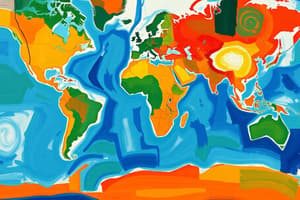Podcast
Questions and Answers
What is an example of human adaptation to the environment?
What is an example of human adaptation to the environment?
- Constructing roads for transportation
- Building dams to control floods
- Deforestation for agriculture
- Wearing clothing suitable for the climate (correct)
Formal regions are defined by unofficial boundaries.
Formal regions are defined by unofficial boundaries.
False (B)
What are the three types of regions?
What are the three types of regions?
Formal regions, functional regions, vernacular regions.
_____ refers to the arrangement of phenomena across space.
_____ refers to the arrangement of phenomena across space.
Match the following concepts with their definitions:
Match the following concepts with their definitions:
Which of the following best describes a 'sense of place'?
Which of the following best describes a 'sense of place'?
Movement includes the migration of people and the exchange of goods.
Movement includes the migration of people and the exchange of goods.
What is the primary effect of understanding spatial patterns?
What is the primary effect of understanding spatial patterns?
Physical characteristics of a place include landforms, climate, and _____ .
Physical characteristics of a place include landforms, climate, and _____ .
What term describes the characteristics that define a location?
What term describes the characteristics that define a location?
Flashcards are hidden until you start studying
Study Notes
Themes of Geography
Human-Environment Interaction
- Definition: Examines how humans adapt to, modify, and depend on their environment.
- Key Concepts:
- Adaptation: Adjusting lifestyles to fit environmental conditions (e.g., clothing, housing).
- Modification: Altering the landscape (e.g., agriculture, urbanization).
- Dependence: Relying on natural resources (e.g., water, minerals) for survival and economic activities.
Place
- Definition: Focuses on the physical and human characteristics that define a location.
- Key Concepts:
- Physical Characteristics: Landforms, climate, vegetation, wildlife.
- Human Characteristics: Culture, architecture, language, population.
- Sense of Place: Emotional attachment and significance of a location to people.
Region
- Definition: Areas that are defined by certain unifying characteristics.
- Types of Regions:
- Formal Regions: Defined by official boundaries (e.g., countries, states).
- Functional Regions: Defined by a function or interaction (e.g., metropolitan areas).
- Vernacular Regions: Perceived regions based on informal boundaries (e.g., "the South").
Movement
- Definition: Explores the mobility of people, goods, and ideas across the planet.
- Key Concepts:
- Migration: Movement of people from one place to another (e.g., urbanization, refugee movements).
- Trade: Exchange of goods and services that connects economies.
- Communication: Spread of information through technology and media.
Spatial Patterns
- Definition: Analyzes the arrangement of phenomena across space.
- Key Concepts:
- Distribution: How features are spread over an area (e.g., population density).
- Density: Number of occurrences within a given area (e.g., people per square mile).
- Concentration: Clustering of phenomena (e.g., urban areas vs. rural areas).
- Importance: Understanding spatial patterns helps in urban planning, resource management, and environmental conservation.
Human-Environment Interaction
- Definition: Studies the relationship between humans and their environment, highlighting adaptation, modification, and dependence.
- Adaptation: Individuals and communities adjust their lifestyles based on environmental conditions, such as choosing appropriate clothing or building suitable housing.
- Modification: Includes significant changes to landscapes through practices such as agriculture, deforestation, and urban development.
- Dependence: Humans rely on natural resources, such as water and minerals, to sustain daily life and support economic activities.
Place
- Definition: Examines the unique physical and human characteristics that define a specific location.
- Physical Characteristics: Elements like landforms (mountains, rivers), climate (temperature, precipitation), vegetation (forests, grasslands), and wildlife.
- Human Characteristics: Includes aspects like cultural practices, architectural styles, languages spoken, and population demographics.
- Sense of Place: Refers to the emotional connection individuals have with a location, influenced by memories, experiences, and cultural significance.
Region
- Definition: Identifies areas defined by shared characteristics, helping to categorize the earth's surface.
- Formal Regions: Regions that have clear, demarcated boundaries such as countries, states, or cities.
- Functional Regions: Areas defined by a specific function or interaction, such as metropolitan areas that serve as economic or social hubs.
- Vernacular Regions: Informal regions perceived by the populace, characterized by widely held beliefs, such as the concept of "the South" in the United States.
Movement
- Definition: Investigates the flow of people, goods, and information across different locations globally.
- Migration: Describes the relocation of individuals or groups, often linked to urbanization trends or refugee crises.
- Trade: The exchange of goods and services that creates economic interconnections between different regions and countries.
- Communication: Encompasses the dissemination of information through technology and media, which can span cultural and geographical boundaries.
Spatial Patterns
- Definition: Focuses on the arrangement and distribution of various phenomena across space.
- Distribution: Analyzes how population and features are spread out within an area, impacting resource allocation and urban planning.
- Density: Refers to the quantity of occurrences (e.g., number of people) within a specific area, providing insight into population trends.
- Concentration: Examines the clustering of phenomena, contrasting urban regions with rural settings to understand societal development.
- Importance: Recognizing spatial patterns aids in effective urban planning, resource management, and strategies for environmental protection.
Studying That Suits You
Use AI to generate personalized quizzes and flashcards to suit your learning preferences.




